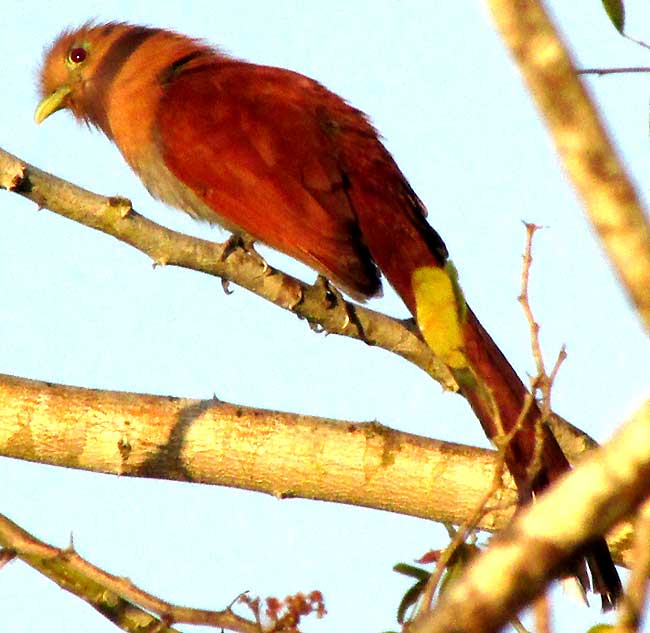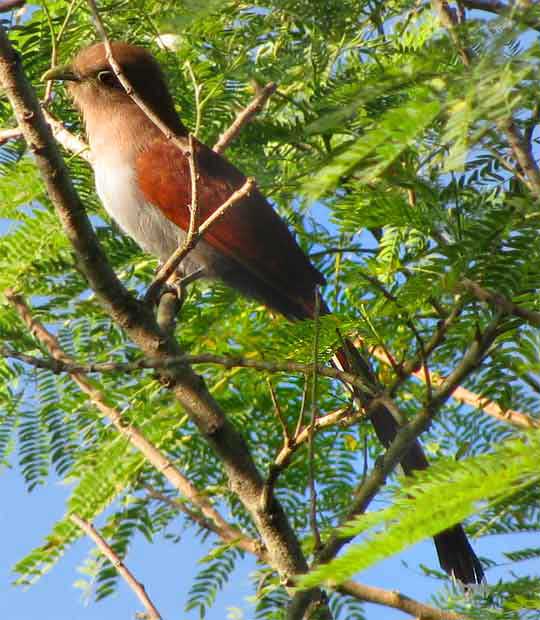Excerpts from Jim Conrad's
Naturalist Newsletter
from the March 23, 2020, issued from the forest just west of Tepakán; elev. ~9m (~30 ft), N21.053°, W89.052°; north-central Yucatán state, MÉXICO
SQUIRREL CUCKOO PICTURE
A nice one, here in the very hot, dry dry-season:

from the November 3, 2008 Newsletter written in Yokdzenot, central Yucatán, MÉXICO
SQUIRREL CUCKOO
Walking along a trail, from a thicket erupts a gruff, nasal chek-e-REHR! and a flash of rusty red, then there's an 18-inch (45 cm) bird in shadows eying you, as shown below.

It's not rare to see this bright, rusty red bird because the species is fairly common and the birds tend to glide across roads before you. When they're close enough and still enough for a picture, however, usually they're in deep shadows.
Squirrel Cuckoos, PIAYA CAYANA, are real cuckoos, of the Cuckoo Family, the Cuculidae. One piece of evidence for that is the bold black-and-white barring on the long tail's undersurface, which is very similar to that of North America's Yellow-billed Cuckoo. The curve-topped bill is typical of cuckoos, too. In Mexico two Squirrel Cuckoo subspecies are recognized. On the Pacific slope there's ssp. mexicana whose undertail is barred rufous and white, unlike our ssp. thermophila on the Gulf slope, with its undertail barred black and white. In Mexico the species is absent from the chilly uplands and arid north.
Distributed from Mexico to northern Argentina, this is one of Tropical America's emblematic birds.

from the August 22, 2010 Newsletter issued from Hacienda Chichen Resort beside Chichén Itzá Ruins, central Yucatán, MÉXICO; limestone bedrock, elevation ~39m (~128ft), ~N20.676°, ~W88.569°
AUGUST CUCKOO
Maybe you're familiar with that feeling that comes in late summer or early fall when days are definitely growing shorter, the sky's haze has cleared out leaving a deep blueness, and in the resulting contrasty world the skin-crisping sunlight is intense, and coolish shadows are satiny black. We've had a little of that feeling here this week. I don't know whether the feeling always comes at this time of year, or if it's just a transient state.
Up North during the season of this feeling, that's when you often see birds molting, and I'm seeing the same here. For example, the other day I saw a Squirrel Cuckoo who'd completely lost his tail, and the rest of his plumage wasn't in a great shape, either. It was early morning after a big rain the previous evening and a drippy night. He perched spreading his wings against the drying morning sunlight as seen below:

The picture at the top of this page is prettier than the one above, but somehow this bottom one engages me more, because it so well captures the feeling of our soggy but brilliant mornings, the welcome feeling of the day's first drying-out sunlight, and the vivid contrasts such days are full of.